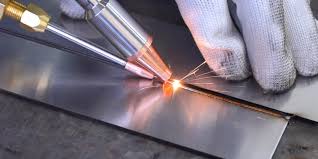As laser welding technology matures and expands across industries, its cost has become more accessible. Many systems now sell for about half of what they did just a few years ago, lowering the barrier to entry for many businesses. This technology offers significant advantages in speed, precision, and final quality. Still, despite falling prices, the primary question for prospective buyers remains: “How much does a laser welder cost?”
There is no single answer. Costs can vary dramatically based on power, type, features, and brand. This guide will break down the typical price ranges, explore the key factors that drive these costs, and look at the total cost of ownership. Our goal is to provide the clarity you need to determine if this technology is a worthwhile investment for your specific needs.
Typical Price Ranges for Laser Welders
These figures are estimates, current as of mid-2025, and can fluctuate based on market conditions and specific configurations. They provide a reliable baseline for what to expect.
- Handheld Fiber Laser Welders: This is the most popular category for workshops seeking versatility and performance.
- Lower Power ($2,000 – $3,500): Now commonly starting at 1.5kW, this power level is ideal for thinner materials and less demanding jobs. Price variations in this range are mainly tied to brand reputation and included features.
- Mid-Range ($3,000 – $8,000): Covering the popular 2kW to 3kW power levels, this segment is a workhorse for many shops. These models almost always include standard features like wobble heads, which improve weld quality and appearance.
- Higher Power ($6,000 – $10,000+): Featuring 3kW and higher outputs, these machines are built for welding thicker materials or for high-speed, demanding production environments.
- Jewelry Laser Welders : Specifically designed for jewelry manufacturing and repair, these welders prioritize extreme precision. They often include integrated microscopes and use lower-power fiber or pulsed YAG sources ideal for delicate work on precious metals. Their price commonly falls between $2,500 and $6,000+, influenced heavily by pulse control features, microscope quality, and brand.
- Automated / Robotic Laser Welding Systems: These are fully integrated solutions for high-volume production. Combining a laser source with a multi-axis robot, custom fixtures, and mandatory safety enclosures, these systems command significantly higher prices, typically starting around $30,000 and easily exceeding $100,000.
Why Such a Big Difference? Key Factors Influencing Cost
Understanding the components that drive the price is essential for evaluating any quote.
- Laser Power (kW): For most industrial welders, power is the single biggest factor in cost. Higher power, measured in kilowatts (kW), allows you to weld thicker materials or increase your travel speed. A 3kW welder will naturally cost more than a 1.5kW model from the same brand.
- Core Components: Quality & Brand: The internal hardware is critical.
- Laser Source: This is the heart of the machine. The brand of the laser source heavily influences cost and long-term performance. Renowned brands like IPG Photonics command a premium due to their reputation for consistency and reliability, while others like Raycus or Maxphotonics offer a more budget-friendly entry point.
- Other Components: The quality of the optics (lenses, protective windows), scan head, wiring, and overall machine construction affects durability, reliability, and ultimately, the price.
- Machine Configuration & Key Features:
- Wobble Head / Beam Oscillation: This feature allows the laser beam to move in small patterns (e.g., a circle or line), widening the weld seam. This improves aesthetics and makes the welder more forgiving of small gaps between parts.
- Integrated Functions: Many handheld welders now come standard as 3-in-1 systems (welding, cleaning, cutting). Upgrading to a 4-in-1 or 5-in-1 system with more specialized processes adds to the cost.
- Cooling System: An efficient water chiller is vital for the laser’s health and stable operation. Higher-capacity, better-quality chillers are required for more powerful lasers and add to the overall cost.
The Used Laser Welder Market: A Cost-Effective Alternative?
For businesses cautious about investing in new technology, the used market is a viable option. The primary advantage is significant cost savings, often between 30-60% less than a new machine.
However, there are risks. A used welder may come without a warranty, meaning you are responsible for any repair costs. It may also feature older technology, lacking the efficiency or features of modern units. To mitigate these risks, perform thorough due diligence. Key considerations include:
- Laser Source Hours: Ask for the total operating hours on the laser source.
- Service History: Request maintenance logs to see how well it was maintained.
- Parts Availability: Confirm that spare parts and consumables are still easy to find.
- Inspection & Demo: Always inspect the machine in person and request a demonstration to see it perform.
Thinking Beyond the Sticker Price: Total Cost of Ownership (TCO)
A smart investment evaluation looks past the initial purchase price. The Total Cost of Ownership (TCO) includes all recurring expenses over the machine’s life. These include:
- Consumables: Protective lenses, nozzles, and shielding gas (like Argon).
- Electricity: Power consumption of the laser source and the chiller.
- Maintenance: Routine cleaning, chiller fluid changes, and potential repairs.
- Safety Equipment: Certified laser safety glasses, fume extraction systems, and protective barriers.
- Training: While many reputable suppliers provide comprehensive initial training free of charge, you may need further training for new operators down the line.
Conclusion: Understanding Laser Welder Pricing
Laser welders can cost very different amounts. You can find a basic handheld one for a few thousand dollars. But a fully automatic system can cost over one hundred thousand. The final price depends on how much power it has, how good the parts are, what features it has, and how good the support from the company is.
When you look at a laser welder’s cost, don’t just look at the initial price. Think about the total cost of ownership over time. Also, consider the return on investment from increased productivity, enhanced product quality, and the reduced need for post-weld cleanup. By knowing exactly what you need and comparing what good companies offer, you can make a smart choice. For expert guidance in selecting a laser welding system that truly helps your business, you can contact a specialist like Riselaser.





























